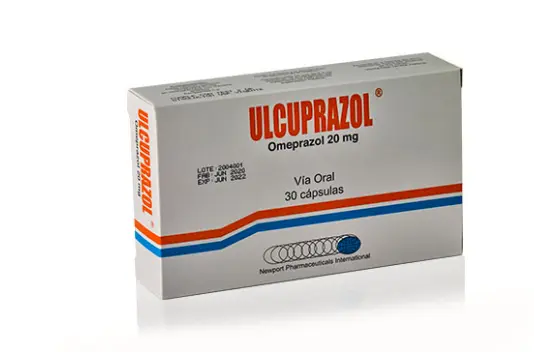Ulcuprazol is a great substitute for those looking for treatments to reduce stomach discomfort because of its increasing recognition for its possible efficacy in treating a range of digestive issues. This comprehensive guide will teach you all there is to know about this, including its applications, dosage, potential adverse effects, and chemical composition.
ULCUPRAZOL: WHAT IS IT?
Ulcuprazol is a member of the potassium-competitive acid blocker (P-CAB) drug class. Following FDA clearance, it was approved in 2021 for the treatment of peptic ulcers and gastroesophageal reflux disease (GERD).
Ulcuprazol functions by reducing the production of gastric acid. It does this via binding to potassium channels on the stomach’s parietal cells. Because it prevents the parietal cells from generating hydrochloric acid, the stomach’s acidity is decreased. This reduction in acidity helps with ulcer pain as well as the healing process itself. Ulcipravazol principally acts on acid secretion, providing comfort and aiding in the management of disorders linked to excessive production of stomach acid.
Overview Of Ulcuprazol’s Past
Ulcuprazol has been a proven treatment for gastrointestinal issues for a very long time. When people discovered its medical benefits in antiquity, they quickly began to use it. Even in the present era, we still rely on its effectiveness to maintain the health of our stomachs. Since ulcuprazol is known to be useful in treating digestive issues, its usage has become widespread. For many generations, it has been a reliable medication.
How Does Ulcapraz Work?
Ulcipravazol lowers the production of stomach acid by inhibiting the H+/K+ ATPase enzyme system on the secretory surface of gastric parietal cells. This enzyme, sometimes referred to as the proton pump, is what causes the stomach to produce acid. Ulcuprazol, which functions as an inhibitor and obstructs the final stage of acid formation, is essentially a gastric acid pump inhibitor, with omeprazole serving as its representative. The inhibitory activity is dose-dependent and inhibits both baseline and stimulated secretion, regardless of what causes the formation of acid.
Omeprazole, the active component of Ulcuprazol, is rapidly eliminated from circulation but remains in the stomach for at least a day, according to animal studies. Its continual presence improves its ability to maintain and reduce stomach acidity and boosts its effectiveness in controlling acid secretion.
Ulcuprazol’s Pharmacodynamics
AVOIDABLE ACTIVITIES
Omeprazole’s antisecretory actions become apparent after oral delivery, peaking two hours after oral treatment. These effects start to take effect quickly. It is noteworthy to note that the secretion inhibition persists for up to 72 hours while having a very short half-life (less than an hour). The medication has a prolonged impact because it binds to the parietal H/KATPase enzyme.
OTHER EFFECTS:
Oral omeprazole at doses of 30 or 40 mg for two to four weeks did not cause any discernible changes in thyroid function, glucose metabolism, or blood levels of different hormones. These hormones include prolactin, cholecystokinin, testosterone, cortisol, and estradiol.
Omeprazole at a dose of 90 milligrams did not affect the stomach’s capacity to pass a test meal that included both liquid and solid components. Omeprazole treatment for 14 days caused a significant increase in the intragastric concentration of live bacteria in healthy volunteers, similar to other drugs that raise intragastric pH. A noteworthy result is that the bacteria that were found had a pattern that is typical of saliva.
Relationships between Medications
Medications that Combine with Ulcuprazol
You must tell your healthcare practitioner about all of the drugs you are presently taking before beginning Ulcipprazol. Clopidogrel and diazepam are two examples of drugs that may interact with it and reduce its efficacy. To guarantee the best possible treatment results, your healthcare professional can assess your existing drug schedule and make any required modifications.
Items and Drinks to Steer Clear of When Taking Ulcuprazol
This may interact with certain foods and beverages in addition to medications. When using it, it is usually advised to stay away from significant doses of caffeine, alcohol, and acidic meals. These drugs have the potential to worsen the formation of stomach acid and decrease the medication’s efficacy.
Ulcuprazol’s Pharmacokinetics
ABSORPTION
The enteric coating on the granulated omeprazole in Ulcuprazol capsules postpones the onset of absorption until the granules exit the stomach.
Omeprazole takes thirty to thirty-five minutes to reach its peak plasma concentration due to its rapid absorption. The area under the curve (AUC) and peak plasma concentrations (PPCs) of omeprazole exhibit a clear correlation for dosages between 20 and 40 mg. However, at dosages more than 40 mg, a saturated first-pass action results in a non-linear response in peak plasma concentration and AUC.
DISPLAY:
95% of omeprazole’s binding occurs to proteins. Since omeprazole binds to proteins in the circulation in significant quantities, this likely has an impact on its availability and distribution for therapeutic effects.
ANALYSIS:
Omeprazole interacts with the cytochrome P450 enzyme system, particularly the CYP enzyme group, to facilitate its metabolic breakdown. This mechanism aids in metabolism, the process by which omeprazole is changed into other chemicals. Omeprazole’s extensive metabolism suggests that it undergoes a lot of modifications in the body, most likely with the assistance of the CYP enzyme system.
SYSTEM.EXCRETION:
After taking one oral dosage of buffered omeprazole, urine tests only contained traces of the medication. Since the majority of the dose was found in the feces, there was a considerable quantity of omeprazole metabolites eliminated through the bile.
GERIATRICS
Elderly patients have been observed to have a reduced rate of omeprazole elimination. Omeprazole is a pill that is frequently used for gastrointestinal issues. In this group, there was a greater rate of drug bioavailability. A single oral dosage of 40 mg of omeprazole in a buffered solution demonstrated a bioavailability of 76% in healthy elderly individuals and 58% in young volunteers.
An examination of the urine revealed that no discernible quantity of the original medication was present and that more than 70% of the dose was eliminated, mostly as omeprazole metabolites.
IMPAIRMENT OF HEPATOSIS
In individuals with chronic liver disease, the medicine is almost 100% more efficiently absorbed when taken orally as opposed to intravenously. The lowered first-pass effect is the reason for the enhanced bioavailability. Also, the plasma half-life of this medicine is over three hours longer than that of those with normal liver function, which is between 0.5 to 1 hour.
The average plasma clearance for the medication in individuals with hepatic impairment is often 70 mL/min, significantly less than the 500–600 mL/min seen in those with sufficient liver function.
IMPAIRMENT OF GENERAL
Omeprazole metabolism was very similar in those with chronic renal impairment and healthy volunteers, with creatinine clearances varying between 10 and 62 mL/min. However, there was minimal improvement in bioavailability.
Since omeprazole metabolites are mostly excreted in urine, their excretion slowed down proportionately when creatinine clearance was decreased.
Applications for Ulcuprazol
Ulcuprazol is used to address a variety of illnesses, including:
- PYROSIS (HEARTBURNS)
- GERD, or gastroesophageal reflux disease
- ELIMINATION OF STRESS
- DUODENAL ULCERS
- Syndrome Zellinger-Ellison
- DISORDERS RELATED TO ACID
- LONG-TERM NSAID THERAPY AND ACID ASPIRATION
- PROPHYLAXIS
Ulcuprazol Side Effects
Ulcipprazol may result in several undesirable side effects, including:
- headaches,
- stomachaches
- flatulence
- Diarrhea, vomiting, and queasy
- pulmonary pneumonia
- issues related to acidity,
- constipation,
- rash
- coughed
Less Common Adverse Outcomes:
- fracture (associated with osteoporosis)
- A decrease in granulocytes in the blood due to hunger
- Polyps in the digestive system
- hip dislocation
- Axon death, chronic stomach discomfort, hair follicle dysfunction, and changed taste perception
Uncommon Side Effects
Among the potentially fatal adverse effects include pancreatitis, liver and renal disorders, and epidermal necrolysis caused by toxins.
Notice:
It’s crucial to keep in mind that there might be other side effects and that this is not an exhaustive list of all potential drawbacks.
Seeing a healthcare professional is advised if you want to learn more about any potential side effects.
Conclusion
Peptide acid blockers (P-CABs), like Ulcuprazol, are effective in treating a range of gastrointestinal conditions, including gastroesophageal reflux disease (GERD) and peptic ulcers. It functions by binding to gastric parietal cells’ potassium channels, which lowers the production of stomach acid. Understanding its pharmacodynamics, pharmacokinetics, and applications is essential for informed use.










Leave a Reply